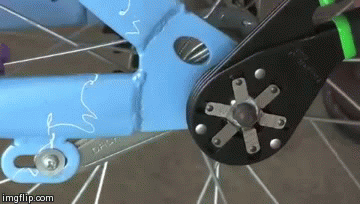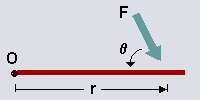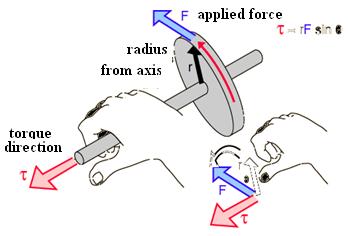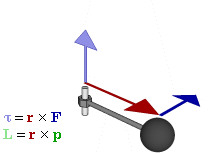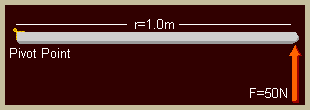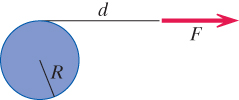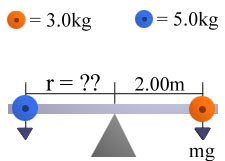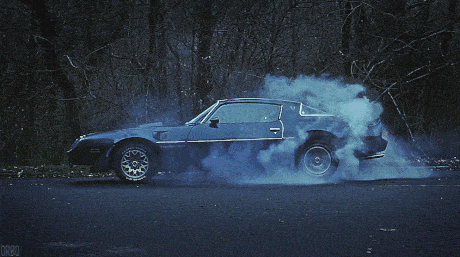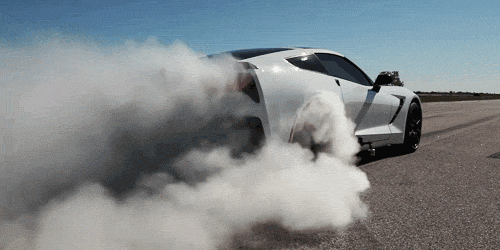Talk:Main Page
Torque -
Torque is a Latin word that roughly means "twist," and is usually symbolized by the lower case Greek letter tau. Torque is the measurement of how much a force, F, acting on an object will cause that object to rotate. This force is usually applied to an arm of some sort that is attached to a fulcrum or pivot point. For example, using a wrench to loosen or tighten a nut requires the use of torque - where the wrench would be the arm you apply the force to and the nut would be the pivot point that the force rotates around.
The Main Idea
In "Matter & Interactions, Fourth Edition," torque is defined as τ = rA x F . Applying a torque to an object changes the angular momentum of that object. Torque, in angular momentum calculations, is analogus to Fnet in regular momentum calculations. Just like how a collection of forces acting on a system is called Fnet, a collection of torques acting on a system is τnet.
A Mathematical Model
Torque is defined as the cross product of the distance vector, the distance from pivot point to the location of the applied force, with an applied force. The magnitude of torque can be defined as such:
- τA = rAFsinθ
Torque can also be defined as τ = dL/dt , or the derivative of angular momentum, L. To determine the direction of torque, one can either compute the cross product or apply the "right-hand rule." To use the "right-hand rule," point your fingers in the direction of rA and curl your fingers in the direction of F.
If your thumb points up, the force is coming out of the page and is in the positive z-directon. If your thumb points down, the force is going into the page and is in the negative z-direction.
A Computational Model
The above picture is a great example of what torque would look like in the real world. To make a similar simulation in vpython, all you would need to do is update position and angular momentum. The code would look something like this:
While t<some number:
L=L+tnet*deltat
v=L/mass
r=r+v*deltat
t=t+deltat
Where L is your angular momentum initialized earlier, tnet is total torque, deltat is your time step, and r is your original location.
Examples
Be sure to show all steps in your solution and include diagrams whenever possible
Simple
In a hurry to catch a cab, you rush through a frictionless swinging door and onto the sidewalk. The force you extered on the door was 50N, applied perpendicular to the plane of the door. The door is 1.0m wide. Assuming that you pushed the door at its edge, what was the torque on the swinging door (taking the hinge as the pivot point)?
(50N)(1.0m)sin(90) = 50 Nm
Middling
A uniform solid disk with radius 9 cm has mass 0.5 kg (moment of inertia I = ½MR2). A constant force 12 N is applied as shown. At the instant shown, the angular velocity of the disk is 25 radians/s in the −z direction (where +x is to the right, +y is up, and +z is out of the page, toward you). The length of the string d is 14 cm.
What are the magnitude and direction of the torque on the disk, about the center of mass of the disk?
(12N)(0.09m)= 1.08 Nm
Direction: -z direction because of the right hand rule
Difficult
We want to place another mass on the see-saw to keep the see-saw from tipping. The only other one we have is a 5.0kg mass. Where would we place this to balance the original 3kg mass that was placed 2.00m to the right of the pivot point?
(3kg)(9.8 m/s^2)(2.00m) = (5kg)(9.8 m/s^2)(x)
58.8 = 49x
x=1.2
Connectedness
How is this topic connected to something that you are interested in? I have a heavy interest in cars. More specifically, I love race cars, and I love watching Formula1, BTCC, WRC, and other car racing series. Torque, in cars, gives you an idea of how fast the car can accelerate. But more importantly, torque can make cars do this:
and this:
How is it connected to your major?
Torque is heavily related to mechanical engineering. Whether it be driving a conveyor belt in a factor, a driveshaft in a car, turning a wrench, or otherwise, torque is involved in almost all mechanical systems. Mechanical engineers use torque to transform energy into a useful form. For example, they use torque in electric motors to turn electric energy into rotational energy that can be used in all sorts of appliances. Mechanical engineers also take the chemical energy from gasoline combustion and turn it into torque to power planes, trains, and automobiles. Torque is applicable in all types of engineering.
Is there an interesting industrial application?
The amount of industrial applications of torque is nearly infinite, but one machine I find interesting is the lathe. The lathe uses torque and rotation to shape various materials [1]
History
The idea of torque originated with Archimedes studies on levers. Archimedes may not have invented the lever, but he was one of the first scientists to investigate how they work in 241 BC.
See also
Further reading
Books, Articles or other print media on this topic
External links
[4] [https://en.wikipedia.org/wiki/Torque [5]] [6]
References
This section contains the the references you used while writing this page [[7]] [8] [9]
Circuits (R, LC, RL)
Circuit Elements
In terms of physics, an electrical circuit is a system which is composed of certain combinations of circuit elements, including resistors, capacitors, and inductors. When used in different combinations, these elements create R, LC, RL, RC circuits. The elements that make up these circuits include capacitors, resistors, batteries, ammeters, voltmeters, ohmmeters. When an electric field is applied to a conductor, the mobile charges in the conductor experience forces, and to move in the direction of those forces. Active circuits do not experience equilibrium, rather they experience a steady state in which means that charges are moving, but their drift velocities do not change with time. For circuits, equilibriums means that there is no current flowing.
Contents [hide] 1 The Main Idea 1.1 A Mathematical Model 1.2 A Computational Model 2 Examples 2.1 Simple 2.2 Middling 2.3 Difficult 3 Connectedness 4 History 5 See also 5.1 Further reading 5.2 External links 6 References The Main Idea To create an active circuit there must be a specific combination of the elements above as well as a nonzero electric field in the wires. The direction of the electric field at every location must be along the wire since the current flow follows the wire. According to the loop rule, energy must be conserved along any closed path in a circuit. Although, using resistors, capacitors, ammeters, voltmeters, ohmmeters, and batteries the flow of current can change with time.
A Mathematical Model In the steady state the net electron current can be shown in the equation: i=nAuE
the conventional current can be solved for through the equation: I=|q|nAuE
Energy conservation (the loop rule): Net change in potential=0
A Computational Model
/Users/maggiegarratt/Desktop/Screen Shot 2015-12-05 at 6.45.05 PM.jpg
A proton moving in a circular motion parallel to the xz plane. Because the particle has both an and y component of velocity, the particles path is a helix.
Example 1
Solve for the current in the resistor:
[File:/Users/maggiegarratt/Desktop/simple.jpg]
Example 2
[File:/Users/maggiegarratt/Desktop/Screen Shot 2015-12-05 at 7.59.03 PM.jpg]
Example
[File:/Users/maggiegarratt/Desktop/Screen Shot 2015-12-05 at 7.56.37 PM.jpg]
Circuits provide the world with many conveniences. From simple circuits within flashlights to parallel circuits in household lighting everyday life is made simpler because of their existence. The difference between parallel and series circuits can be noted through the reaction of Christmas lights to a bulb burning out. If a bulb burns out in a series circuit the entire string of lights will burn out as well. This is because in a series circuit there is only one pathway for the current to flow. When the pathway is disrupted the current is in equilibrium and stops flowing. On the other hand, if a bulb burns out and the remaining bulbs stay lit you know they are connected through a parallel circuit. When the bulbs are connected in parallel there are multiple alternate pathways for the currents to travel in.
Many careers necessitate an in-depth knowledge of circuits. For the major of mechanical engineering a knowledge of circuits is beneficial for multiple applications. When designing electronic technologies it is necessary to understand the circuitry within the design.
History
Early investigations of static electricity go back hundreds of years. Static electricity is a transfer of electrons produced by friction, like when you rub a balloon across a sweater. A spark or very brief flow of current can occur when charged objects come into contact, but there is no continuous flow of current. In the absence of a continuous current, there is no useful application of electricity.
The invention of the battery -- which could produce a continuous flow of current -- made possible the development of the first electric circuits. Alessandro Volta invented the first battery, the voltaic pile, in 1800. The very first circuits used a battery and electrodes immersed in a container of water. The flow of current through the water produced hydrogen and oxygen.
The first widespread application of electric circuits for practical use was for electric lighting. Shortly after Thomas Edison invented his incandescent light bulb, he sought practical applications for it by developing an entire power generation and distribution system. The first such system in the United States was the Pearl Street Station in downtown Manhattan. It provided a few square blocks of the city with electric power, primarily for illumination.
One classification of circuits has to do with the nature of the current flow. The earliest circuits were battery-powered, which made in a steady, constant current that always flowed in the same direction. This is direct current, or DC. The use of DC continued through the time of the first electric power systems. A major problem with the DC system was that power stations could serve an area of only about a square mile because of power loss in the wires.
In 1883, engineers proposed harnessing the tremendous hydroelectric power potential of Niagara Falls to supply the needs of Buffalo, N.Y. Although this power would ultimately go beyond Buffalo to New York City and even farther, there was an initial problem with distance. Buffalo was only 16 miles from Niagara Falls, but the idea was unworkable -- until Nikola Tesla made it possible, as we'll see on the next page.
See also Are there related topics or categories in this wiki resource for the curious reader to explore? How does this topic fit into that context?
Further reading
The Art of ElectronicsApr 9, 2015 by Paul Horowitz and Winfield Hill
Practical Electronics for Inventors, Third Edition Jan 31, 2013 by Paul Scherz and Simon Monk
Make: Electronics: Learning Through Discovery Sep 7, 2015 by Charles Platt
External links: https://www.khanacademy.org/science/physics/circuits-topic
https://learn.sparkfun.com/tutorials/what-is-a-circuit
http://www.allaboutcircuits.com
References: https://www.webassign.net/ebooks/mi4/toc.html?page=23.8
http://science.howstuffworks.com/environmental/energy/circuit3.htm
Circuits
